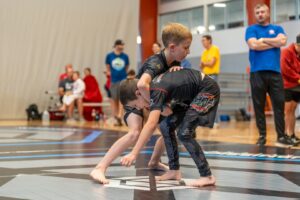In today’s challenging world, parents seek effective ways to equip their children with essential life skills. Bullying is a prevalent issue affecting kids and young teens, encompassing various forms such as cyber, physical, verbal, and social bullying. This blog post explores the positive impact of Jiu-Jitsu training on empowering children, providing parents with valuable insights into how it helps build bully-proofing skills. Discover the different types of bullying, the motivations behind it, its harmful consequences, and how Jiu-Jitsu techniques serve as a last-resort self-defense approach. We emphasize the safe and controlled aspects of Jiu-Jitsu to alleviate concerns that some parents may have. Let’s delve into our comprehensive welcome packet that highlights the importance of non-violent self-defense techniques.
Understanding Bullying:
Understanding bullying and its diverse forms is crucial for addressing the issue effectively. Bullying entails intentional and aggressive acts, characterized by a power imbalance, where one individual persistently targets another. Types of bullying include:
Cyberbullying: Aggression conducted through digital platforms like social media, text messages, or online forums.
Physical Bullying: Direct physical aggression such as hitting, kicking, or pushing.
Verbal Bullying: Hurtful language, insults, or name-calling.
Social Bullying: Exclusion, rumors, or manipulation of social relationships.
Motivations Behind Bullying:
By delving into the motivations behind bullying, we can better address its underlying causes. Bullying may stem from factors like the desire for power and control, attention-seeking behavior, personal insecurities, or imitation of learned patterns. It’s important to remember that bullies themselves often face challenges that manifest through negative behavior.
The Harmful Consequences of Bullying:
Bullying has severe consequences on a child’s mental, emotional, and physical well-being. It leads to low self-esteem, anxiety, depression, social isolation, academic difficulties, and even physical injuries. Equipping children with effective strategies to overcome these challenges is paramount for parents.
The Approach: Talk, Tell, Control
At our academy, we adopt a proactive approach to bullying called “Talk, Tell, Control.” This three-step process prioritizes non-violent strategies and aims to create a safe environment for all children involved.
Talk: We encourage open communication between our students and the bully, emphasizing the importance of expressing feelings and finding resolutions through dialogue. Our training helps children assert themselves confidently while remaining respectful and calm.
Tell: If the bullying persists, children are urged to reach out to trusted adults, such as parents, teachers, or school counselors. Reporting the incidents ensures that appropriate actions can be taken to address the situation effectively.
Control: Jiu-Jitsu techniques are introduced as a last resort for self-defense, prioritizing the safety of our students and the bully. It’s crucial to emphasize that Jiu-Jitsu is not about promoting violence, but rather focuses on leveraging control and neutralizing threats until help arrives.
The Power of Jiu-Jitsu for Bully-Proofing:
Jiu-Jitsu, a grappling-based martial art, offers numerous benefits to children and young teens facing bullying situations. It equips them with valuable self-defense skills while emphasizing control and safety. Here’s why Jiu-Jitsu is an effective tool for bully-proofing:
Non-Violent Self-Defense: Jiu-Jitsu distinguishes itself from striking-based martial arts by focusing on grappling and submission techniques, removing the need for striking or causing harm.
Leverage and Control: Jiu-Jitsu empowers students to utilize leverage, angles, and control to neutralize opponents. It emphasizes minimizing harm to
If you want to learn more check out Lil Champions Jiu-Jitsu page to learn more about how we teach bully proofing techniques. Click Here



